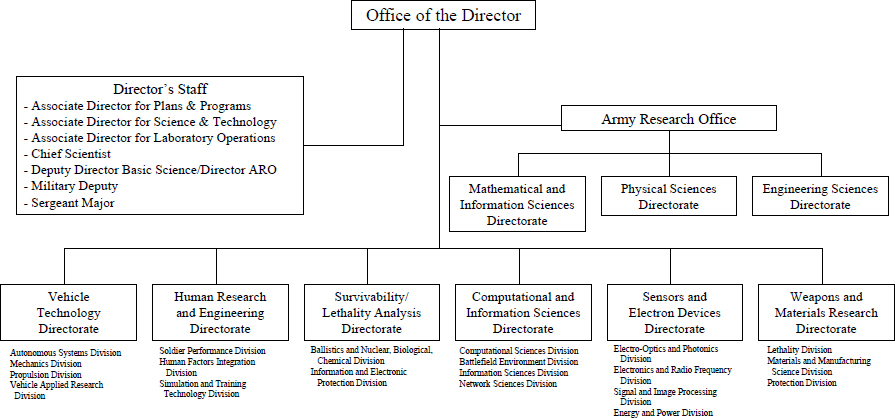A
Army Research Laboratory Organization Chart
Figure A.1 is an organization chart for the Army Research Laboratory (ARL), and Table A.1 maps the ARL organizational chart to the core competency areas reviewed in 2013 and 2014.

FIGURE A.1 Army Research Laboratory organization chart.
TABLE A.1 Mapping the ARL Organization Chart to the Core Competency Areas Reviewed in 2013 and 2014
|
|
||
|
Core Competency Area |
Topic |
ARL Directorate Involved |
|
|
||
|
2013 |
||
|
Ballistic sciences |
Terminal ballistics |
WMRD, SLAD, HRED, SEDD |
|
Human sciences |
Transitional neuroscience |
HRED, SEDD, SLAD |
|
Information sciences |
Autonomous systems |
VTD, CISD, SEDD, HRED |
|
Materials sciences |
Energy materials and devices |
SEDD, WMRD |
|
2014 |
||
|
Ballistic sciences |
Internal and external ballistics |
WMRD, SLAD, HRED, SEDD |
|
Human sciences |
Soldier performance |
HRED |
|
Information sciences |
Network sciences |
CISD, SEDD, HRED, SLAD |
|
Materials sciences |
Electronic materials and devices |
SEDD, WMRD, CISD |
|
Mechanical sciences |
Propulsion |
VTD, WMRD |
|
|
||
NOTE: CISD, Computational and Information Sciences Directorate; HRED, Human Research and Engineering Directorate; SEDD, Sensors and Electron Devices Directorate; SLAD, Survivability and Lethality Analysis Directorate; VTD, Vehicle Technology Directorate; WMRD, Weapons and Materials Research Directorate.



